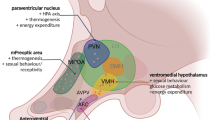Abstract
Evidence is provided here supporting the existence of a novel autacoid mechanism negatively modulating mast cell behaviour in response to noxious stimuliin vivo; hence, the denomination “autacoid local inflammation antagonism” (ALIA). In particular, as lipid amides of theN-acylethanolamine type have been reported to accumulate in tissues in degenerative inflammatory conditions, we examined whether theseN-acylated lipids could exert regulatory effects on mast cell activationin vivo. The results reported show that both long- and short-chainN-acylethanolamines, when systemically administered, are effective in reducing mast cell degranulation induced by local injection of substance P in the earpinna of developing rats. These and other data suggest that the endogenous production ofN-acylethanolamines may constitute a local autocrine/paracrine response for the negative feedback control of mast cell responses to various activating signals. Such a process may be of physio-pathological relevance in the regulation of functional neuroimmune-mast cell interactions.
Similar content being viewed by others
References
J. S. Marshall and J. Bienenstock,Mast cells. Semin. Immunopathol.12, 191–202 (1990).
R. Levi-Montalcini, L. Aloe and E. Alleva,A role for nerve growth factor in nervous, endocrine and immune system. Prog. Neurol. Endocrinol. Immunol.1, 1–10 (1990).
L. Aloe, M. Tuveri, U. Carcassi and R. Levi-Montalcini,Nerve growth factor in the synovial fluid of patients with chronic arthritis. Arth. Rheum.35, 351–355 (1992).
L. Aloe and R. Levi-Montalcini,Mast cell increase in tissues of neonatal rats injected with nerve growth factor. Brain Res.133, 358–366 (1977).
J. S. Marshall, R. H. Stead, C. McSharry, L. Nielsen and J. Bienenstock,The role of mast cell degranulation in mast cell hyperplasia, I. Mechanism of action of nerve growth factor. J. Immunol.144, 1886–1892 (1990).
S.J. Galli, J.R. Gordon and B. Wershil,Cytokine production by mast cells and basophils. Current Opinion Immunol.3, 865–873 (1991).
V. Natarajan, V. P. Reddy, P. C. Schmid and H. H. O. Schmid,N-Acylation of ethanolamine phospholipids in canine myocardium. Biochim. Biophys. Acta712, 342–355 (1982).
O. H. Ganley, O. Graessle and H. J. Robinson,Antiinflammatory activity of compound obtained from egg yolk, peanut oil and soybean lecithin. Lab. Clin. Med.51, 709–714 (1958).
Author information
Authors and Affiliations
Rights and permissions
About this article
Cite this article
Aloe, L., Leon, A. & Levi-Montalcini, R. A proposed autacoid mechanism controlling mastocyte behaviour. Agents and Actions 39 (Suppl 1), C145–C147 (1993). https://doi.org/10.1007/BF01972748
Issue Date:
DOI: https://doi.org/10.1007/BF01972748




